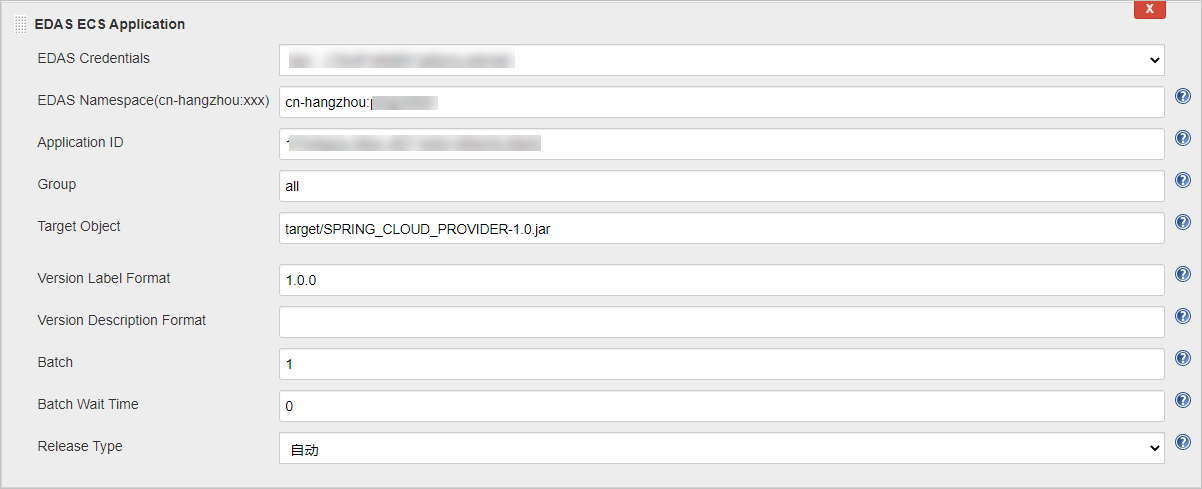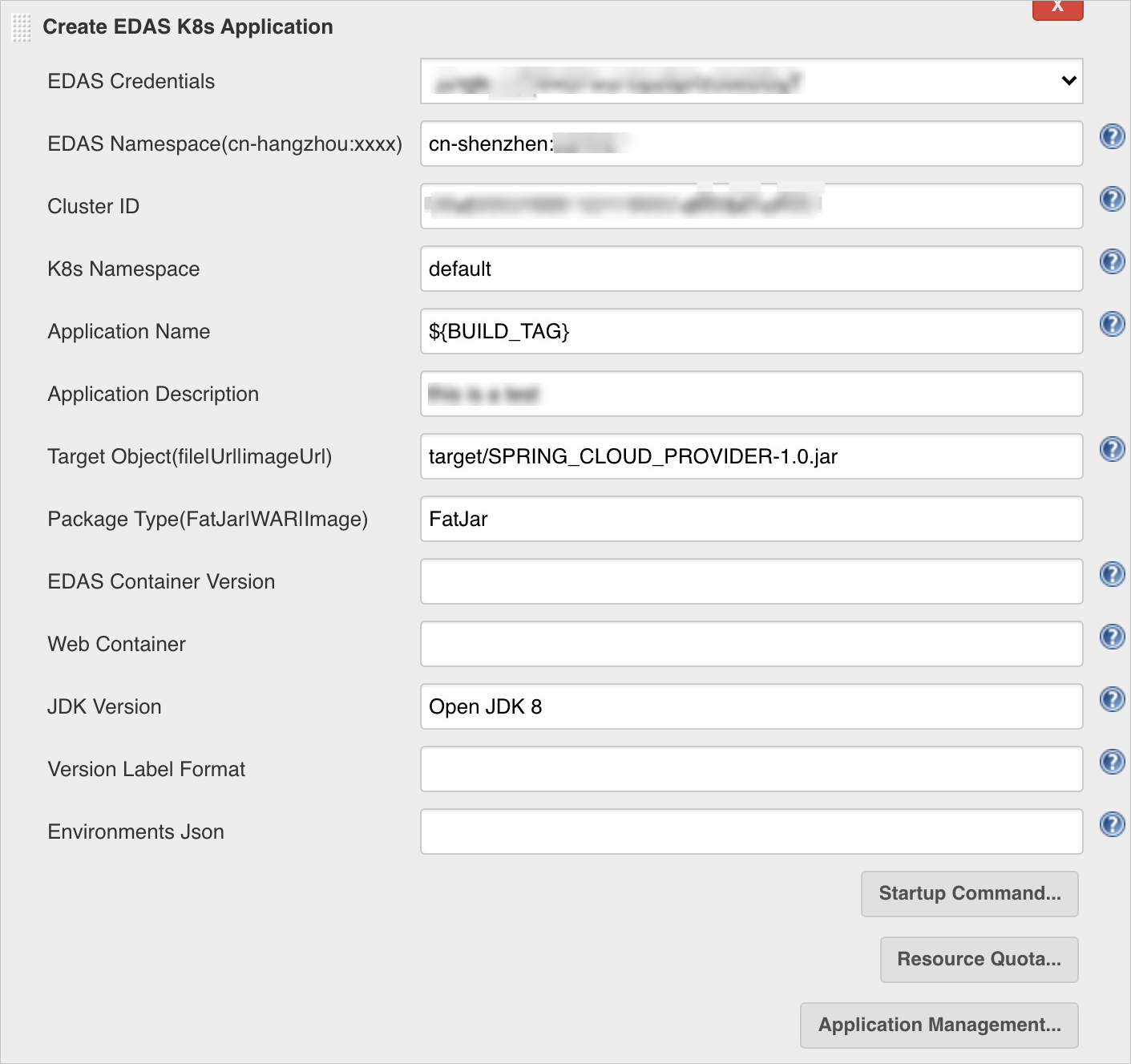If you want to use edas-jenkins-plugin in Jenkins to deploy an application to Enterprise Distributed Application Service (EDAS), you can create or deploy the application in an Elastic Compute Service (ECS) cluster or a Container Service for Kubernetes (ACK) cluster. This topic describes how to set relevant parameters in four scenarios.
Deploy an application to an ECS cluster

| Parameter | Description |
|---|---|
| EDAS Credentials | The AccessKey ID. |
| EDAS Namespace | The microservices namespace in which the application to be deployed resides. Specify
the value in the format of Region ID:Namespace ID, such as cn-hangzhou:doc.
|
| Application ID | The ID of the application to be deployed. |
| Group | The group of the application to be deployed. A value of all indicates that the application belongs to all groups. |
| Target Object | The URL of the package that is used to deploy the application. The package type that you use to redeploy the application must be the same as that you use to deploy the application for the first time. |
| Version Label Format | The version number. |
| Version Description Format | The version description that is in the required format. |
| Batch | The number of phases for the deployment. |
| Batch Wait Time | The interval between two consecutive phases. |
| Release Type | The type of the phased release. The next phase can be manually or automatically started. |
Create and deploy an application in an ECS cluster

| Parameter | Description |
|---|---|
| EDAS Credentials | The AccessKey ID. |
| EDAS Namespace | The microservices namespace in which the application to be deployed resides. Specify
the value in the format of Region ID:Namespace ID, such as cn-hangzhou:doc.
|
| Application Name | The name of the application to be deployed. |
| Package Type | The type of the deployment package. Valid values: WAR and JAR. |
| Cluster ID | The ID of the cluster in which the application to be deployed resides. |
| Target Object | The URL of the package that is used to deploy the application. The package type that you use to redeploy the application must be the same as that you use to deploy the application for the first time. |
| Ecu Info | The elastic compute unit (ECU) ID of the ECS instance that you want to use. For more information, see ListScaleOutEcu. |
| Version Label Format | The version number. |
| Version Description Format | The version description that is in the required format. |
| Build Pack ID | The build package number of EDAS Container. |
| Health Check Url | The health check URL. |
Deploy an application to an ACK cluster
To update and deploy a Spring Boot application in an ACK cluster by using edas-jenkins-plugin
in Jenkins, you can perform the following steps: Go to the Applications page in the EDAS console. Click the name of the application that you want to manage.
On the Application Overview page, choose . On the page that appears, click Start Deployment in the Phased Release section. On the Phased Release page, click Copy Deployment Parameters to copy deployment parameters to a file named UpdateStrategy Json.
When you update and deploy an application in an ACK cluster, set the parameters as prompted, as shown in the following figure. In the following figure, the Application Environment, Startup Command, Resource Quota, and Application Management parameters are optional.

| Parameter | Description |
|---|---|
| EDAS Credentials | The AccessKey ID. |
| EDAS Namespace | The microservices namespace in which the application to be deployed resides. Specify
the value in the format of Region ID:Namespace ID, such as cn-hangzhou:doc.
|
| Application ID | The ID of the application to be deployed. |
| Target Object | The URL of the package or image that is used to deploy the application. The method of redeploying the application must be the same as that of deploying the application for the first time. |
| Whether target imageUrl | If you set the Target Object parameter to the URL of the image that is used to deploy your application, select the check box for this parameter. |
| Application Environment | For more information, see DeployK8sApplication. |
| Startup Command | |
| Resource Quota | |
| Application Management |
Create and deploy an application in an ACK cluster

| Parameter | Description |
|---|---|
| EDAS Credentials | The AccessKey ID. |
| EDAS Namespace | The microservices namespace in which the application to be deployed resides. Specify
the value in the format of Region ID:Namespace ID, such as cn-hangzhou:doc.
|
| Cluster ID | The ID of the cluster in which the application to be deployed resides. |
| K8s Namespace | The Kubernetes namespace of the cluster. Internal system objects are allocated to different Kubernetes namespaces to form logically isolated projects, groups, or user groups. This way, these projects, groups, or user groups can be separately managed but still share the resources of the entire cluster. Select default. |
| Application Name | The name of the application to be deployed. |
| Application Description | The description of the application. |
| Target Object | The URL of the FatJar package, WAR package, or image that is used to deploy the application. |
| Package Type | The deployment method. Valid values: FatJar, WAR, and Image. |
| EDAS Container Version | The version of EDAS Container on which the deployment package of the application depends. This parameter is applicable to High-Speed Service Framework (HSF) applications that you deploy by using WAR packages. This parameter is unavailable if you deploy applications by using images. |
| Web Container | The version of the Tomcat container on which the deployment package of the application depends. This parameter is applicable to Spring Cloud and Dubbo applications that you deploy by using WAR packages. This parameter is unavailable if you deploy applications by using images. |
| JDK Version | The Java Development Kit (JDK) version, such as Open JDK 8. |
| Version Label Format | The version number. |
| Environments Json | The environment variables that are used to deploy the application. Specify the value in the format of a JSON array. |
| Startup Command | For more information, see DeployK8sApplication. |
| Resource Quota | |
| Application Management |